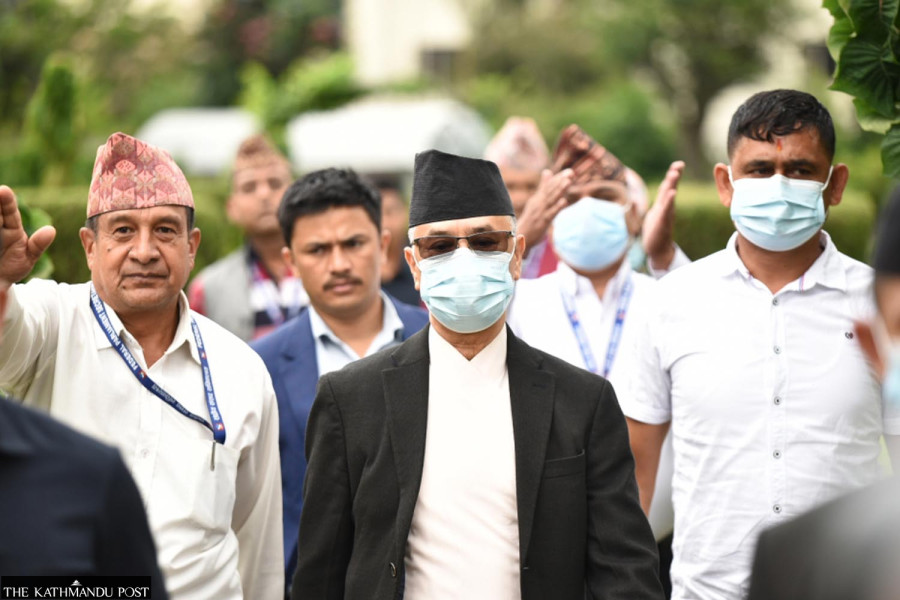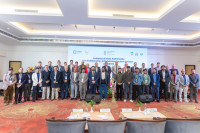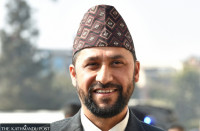National
Chief Justice row may spark more confrontation as neither side ready to relent
Ruling leaders are in a mood to pile pressure on Cholendra Shumsher Rana to leave the official residence.
Tika R Pradhan
With sharp divisions among the political parties on whether the suspended chief justice can give continuity to his duty after the term of the House of Representatives ended without settling the impeachment motion against him, the issue is getting more complicated.
Legal experts and observers have cautioned that the issue could lead to confrontations if the government doesn’t handle it judiciously.
The problem has been further complicated as the respective sides have further toughened their positions. Suspended Chief Justice Cholendra Shumsher Rana, who tried to resume office, was prevented from leaving his residence by the heavy security presence at the gates of his official residence in Baluwatar on Sunday.
The constitutional rights body, the National Human Rights Commission, and CPN-UML leaders, who are against the impeachment motion against Rana, have accused the government of using excessive power to deprive him of movement.
But some legal experts supporting the government's move see it as a measure to avoid confrontations in the judiciary as Rana’s re-entry into the Supreme Court may complicate things there.
According to a Supreme Court justice, who talked to the Post on the condition of anonymity, Rana has three options: continue to stay at the official residence while doing nothing, resign, or keep creating drama while waiting for an opportune moment.
The third option seems more viable given Rana’s forceful nature–especially if he has some strong forces backing him, the justice said.
“But if he decided to return to the Supreme Court, which can’t be ruled out given his nature, that would be an unfortunate moment in the history of our judiciary,” the justice told the Post. “Deepak sriman [honorable acting chief justice Deepak Kumar Karki] is also not in a mood to relent.”
Supreme Court justices continued their regular jobs on Sunday but they have felt some pressure due to disturbances at the court over the past few days.
The government seems determined to stop Rana from returning to the Supreme Court and there are speculations that it could build pressure on him to leave the official residence. Besides restricting his movements, the government has taken away his personal security detail and official vehicles.
“I think the government will continue to build pressure on Rana to leave the official residence,” said a leader close to Pushpa Kamal Dahal, chairman of the CPN (Maoist Centre), asking not to be named. “He [Rana] has been creating problems and so he should vacate the official residence at the earliest.”
As the leader of the major coalition partner of the Sher Bahadur Deuba government, Dahal’s say may be decisive in the row.
Around a hundred lawmakers of the Nepali Congress, the CPN (Maoist Centre) and the CPN (Unified Socialist) had registered an impeachment motion against Rana on February 13 with three dozen charges, leading to his suspension as chief justice.
Former chief justices—who refused the call of the Impeachment Recommendation Committee of the House of Representatives to appear before it—have said the drama will continue until Rana retires as he does not feel ashamed of either the impeachment motion or the recommendation for his impeachment. The decision was taken through majority votes of the committee after members from the main opposition CPN-UML stood against the proposal.
On the 11-member impeachment recommendation committee, six supported the impeachment motion while five representing the UML and a member of the Loktantrik Samajbadi Party stood against it. The majority members submitted their report to Speaker Agni Sapkota, arguing Rana should be impeached for nine different reasons.
However, a defiant Rana informed the secretariat of the Supreme Court that he would rejoin office from Sunday, saying his suspension would be automatically lifted after the term of the House of Representatives that pushed his impeachment ended on Saturday midnight.
But the Supreme Court administration has sent a letter to Rana saying that before returning to the apex court he should produce a letter from the parliament secretariat clearly mentioning that his suspension has been lifted.
Rana will retire on December 12, less than a month after the federal and provincial polls. The new House of Representatives would not be constituted by then.
“These disturbances will continue until Rana goes home after his retirement,” said Anup Raj Sharma, a former chief justice who also led the National Human Rights Commission. “Going by the examples of other countries like India, the impeachment motion should be given continuity in the next Parliament.”
He said since there is no clear constitutional provision for a motion of impeachment unlike in the case of other bills, whose validity automatically ends when the term of the Parliament terminates, it could be carried to the next term.
Though legal experts are divided over whether Rana can resume office, many of them have said that Article 101 (6) of the constitution clearly bars Rana from returning to the apex court. The article states that “after the commencement of impeachment proceedings under clause (2), the chief justice of Nepal or judge of the Supreme Court, member of the Judicial Council, chief or official of a constitutional body will not be allowed to discharge the duties of his or her office pending the settlement of such proceedings.”
As the parliament is yet to settle the issue, Rana doesn’t get the clearance to rejoin the judiciary, they argue.




 20.12°C Kathmandu
20.12°C Kathmandu















